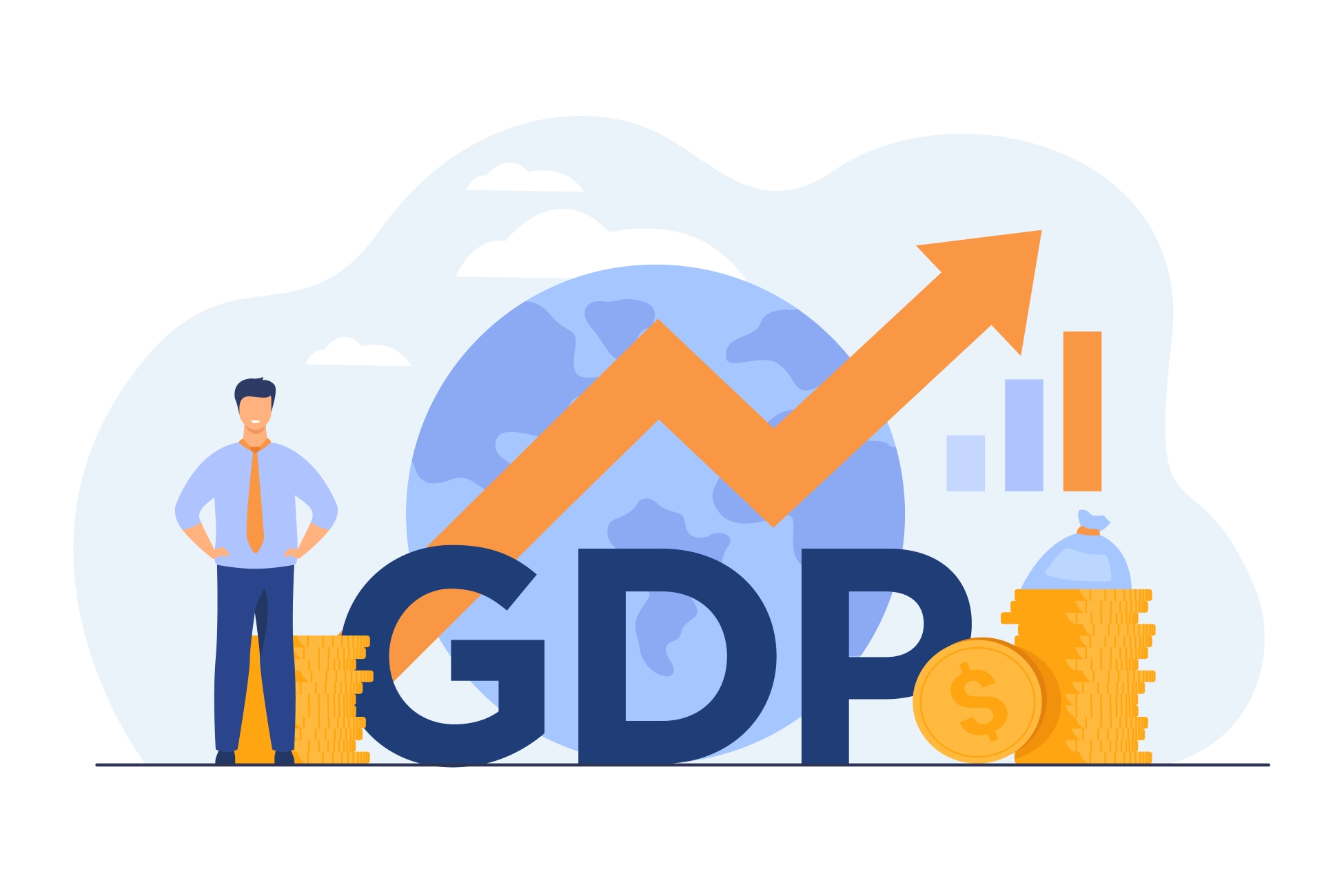
Nominal GDP vs. Real GDP
Understanding the GDP deflator and the distinction between nominal and real GDP is essential for grasping the real health of an economy
Gross Domestic Product (GDP) is the cornerstone of economic measurement, but not all GDP figures tell the same story. At first glance, nominal GDP might seem like the definitive metric for economic performance, but it only scratches the surface. To truly understand an economy’s growth, we must look deeper — adjusting for inflation, comparing purchasing power, and dissecting the GDP deflator. Real GDP strips away the distortions of price changes, offering a clearer picture of whether an economy is genuinely expanding or merely riding the waves of rising prices.
In an era of fluctuating inflation rates and volatile markets, distinguishing between nominal and real GDP isn’t just academic — it’s practical. Policymakers, investors, and business leaders rely on these metrics to make informed decisions. Whether you’re analyzing national economic trends or planning corporate strategy, understanding these concepts ensures you’re working with the right data. This article demystifies the relationship between nominal GDP, real GDP, and the GDP deflator, revealing why the latter holds the key to meaningful economic insight.
GDP is often hailed as the ultimate barometer of a nation’s economic health. It’s cited in news headlines, political debates, and investment analyses. But beneath this singular term lies a critical divide: nominal GDP versus real GDP. The difference between the two isn’t just technical — it’s foundational to interpreting whether an economy is growing in substance or merely in appearance.
Nominal GDP measures the total value of goods and services produced in an economy at current market prices. It’s straightforward but flawed — it doesn’t account for inflation. Real GDP, on the other hand, adjusts for price changes, reflecting true growth in output. The bridge between these two metrics is the GDP deflator, an often-overlooked yet powerful tool that reveals the underlying inflation or deflation within an economy.
Historically, the confusion between nominal and real GDP has led to misguided policies and investment decisions. During periods of high inflation, nominal GDP can paint a rosy picture while real GDP tells a sobering tale of stagnation or decline. Conversely, deflation can mask growth when only nominal figures are considered. The stakes are high: misreading these metrics can lead to everything from flawed monetary policies to misallocated investments.
Today, as global economies grapple with inflationary pressures and supply chain disruptions, the distinction between nominal and real GDP is more relevant than ever. This isn’t just theory — it’s a lens through which we can assess the true trajectory of prosperity.
The Illusion of Nominal GDP
Nominal GDP is the raw, unadjusted measure of economic activity. It sums up everything produced within a country’s borders at their current prices. At face value, it’s a useful snapshot — but it’s also a mirage. When prices rise due to inflation, nominal GDP can increase even if the actual quantity of goods and services remains unchanged. This creates the illusion of growth where none exists.
Consider a simple example: if a country produces the same number of cars this year as last year, but car prices double due to inflation, nominal GDP will show a dramatic increase. Yet, the real output — the actual number of cars — hasn’t budged. This is why economists and policymakers turn to real GDP for a clearer view.
Nominal GDP has its uses, particularly for measuring the size of an economy in current terms. It’s essential for understanding revenue streams, tax bases, and debt ratios. But relying on it alone is like judging a book by its cover — you miss the substance beneath the surface.
The Power of Real GDP
Real GDP cuts through the noise of price fluctuations. By holding prices constant relative to a base year, it isolates changes in actual production. This adjustment transforms GDP from a nominal figure into a real measure of economic progress.
The process involves using a price index — typically the GDP deflator — to “deflate” nominal GDP, stripping out the effects of inflation. The result is a metric that reflects genuine growth in output. For instance, if real GDP grows by 3% in a year, it means the economy has produced 3% more goods and services, regardless of price changes.
Real GDP is indispensable for long-term comparisons. It allows us to track whether living standards are improving, whether productivity is rising, and whether economic policies are fostering sustainable growth. Without it, we’d be left guessing whether a rise in GDP is due to more goods being produced or simply higher prices.
The GDP Deflator: The Unsung Hero
The GDP deflator is the key to unlocking the real story behind economic growth. Unlike consumer price indices (CPI), which focus on a fixed basket of goods, the GDP deflator encompasses all goods and services produced in an economy. It’s a broader, more flexible measure of price changes.
Calculating the GDP deflator is straightforward: divide nominal GDP by real GDP and multiply by 100. The result is an index that shows how much of the change in nominal GDP is due to price increases rather than actual growth. A rising deflator signals inflation; a falling one suggests deflation.
What makes the GDP deflator unique is its comprehensiveness. While CPI tracks consumer prices, the deflator includes investment goods, government spending, and net exports. This makes it a more accurate reflection of overall price movements in the economy. For policymakers, it’s a critical tool for calibrating fiscal and monetary responses.
Why This Matters for You
You might wonder why these distinctions matter beyond academic circles. The answer lies in their real-world implications. For investors, understanding whether GDP growth is nominal or real can mean the difference between betting on a thriving economy or an inflationary bubble. For business leaders, it informs decisions about expansion, hiring, and pricing strategies.
Consider retirement planning: if your savings are growing at a nominal rate but inflation is eroding their real value, you could face a shortfall. Similarly, governments relying on nominal GDP figures might underestimate debt burdens or overestimate tax revenues. The stakes are personal and systemic.
The Human Element in Economic Measurement
Behind every GDP figure lies a story — of workers clocking in overtime to meet demand, of entrepreneurs launching ventures that add value, of families whose purchasing power dictates their quality of life. Real GDP, by cutting through the noise of inflation, reveals whether their collective efforts are translating into genuine progress or being eroded by rising prices. This distinction isn’t just technical; it’s deeply human.
Consider a nurse whose nominal wages rise by 5% in a year. On paper, this suggests improvement. But if inflation runs at 6%, her real income — and her ability to afford groceries, rent, or her child’s education — has actually declined. Real GDP captures this erosion of living standards, while nominal GDP might obscure it. Similarly, a business owner seeing higher revenues might celebrate — until realizing that soaring input costs have left profit margins unchanged. Real GDP separates the signal from the noise.
Economists and policymakers, much like skilled wealth managers, act as interpreters of these narratives. They don’t just crunch numbers; they contextualize them. When central banks set interest rates or governments design stimulus packages, they rely on real GDP to distinguish between true economic expansion and inflationary mirages. Their decisions ripple through jobs, loans, and markets — making their understanding of these metrics a cornerstone of public trust.
This human-centric view also exposes the limits of GDP itself. It doesn’t measure unpaid caregiving, environmental sustainability, or income inequality — yet these factors define societal well-being. The debate over "GDP versus quality of life" reminds us that while real GDP is a powerful tool, it’s not the whole story. The best analysts pair it with other indicators — employment data, consumer sentiment, even carbon footprints — to paint a fuller picture.
Seeing Beyond the Numbers
In finance and economics, what glitters isn’t always gold. Nominal GDP glitters — it’s flashy, headline-grabbing, and often misleading. Real GDP, refined by the GDP deflator, is the gold standard. It’s the measure that tells us whether an economy is truly thriving or just spinning its wheels amid inflation.
For investors, this knowledge is armor against market hype. A country reporting booming nominal GDP might seem attractive — until you realize its real GDP is stagnant, signaling an overheated economy. For business leaders, it’s a compass: expanding into a market with strong real GDP growth means tapping into actual demand, not just price surges. And for everyday citizens, it’s empowerment — understanding whether wage hikes outpace inflation or whether politicians are touting hollow growth.
The COVID-19 pandemic laid bare the stakes. Many economies saw nominal GDP rebound quickly due to stimulus-fueled spending, but real GDP revealed lingering scars in supply chains and productivity. Those who tracked real metrics saw the recovery for what it was — uneven and incomplete — and adjusted their strategies accordingly.
Ultimately, GDP isn’t an abstract concept. It’s the sum of every transaction, every innovation, every hard-earned dollar. Recognizing the difference between its nominal and real forms isn’t just academic — it’s practical wisdom for navigating an uncertain world.
Partnering with Knowledge: Your Path to Clarity
At LUXIM, we understand that economics isn’t just about charts and indices — it’s about the tangible impact on your wealth and future. Just as our wealth management approach harmonizes investments, taxes, and legacy planning, we help you decode economic indicators like GDP to make informed decisions.
Whether you’re an entrepreneur assessing market opportunities, an investor rebalancing your portfolio amid inflation, or a family planning long-term finances, the interplay of nominal and real GDP matters. Our team bridges the gap between macroeconomic trends and personal strategy. We analyze not just what the numbers say, but what they mean for your unique goals — filtering out the noise to focus on real, actionable insights.
Book an appointment today to discuss how GDP trends, interest rate shifts, and inflation impact your financial roadmap. Get in touch with experts for a deep dive into turning economic clarity into competitive advantage. In a world of volatility, knowledge isn’t just power — it’s protection. Let us help you build both.
Related Posts

The True Meaning of Wealth Management
Strategic planning, personalized guidance, and integrated financial decisions are the keys to build lasting wealth and peace of mind

Aggregate Income
Labor, capital, and land — why understanding aggregate income is essential for financial clarity and long-term prosperity

Fiscal Policy
Spending, taxation, and economic vision — why fiscal policy shapes the world investors live in

The True Meaning of Wealth Management
Strategic planning, personalized guidance, and integrated financial decisions are the keys to build lasting wealth and peace of mind

Aggregate Income
Labor, capital, and land — why understanding aggregate income is essential for financial clarity and long-term prosperity

Fiscal Policy
Spending, taxation, and economic vision — why fiscal policy shapes the world investors live in
Disclaimer
The content published on this blog, including articles contributed by LUXIM, is for informational purposes only and should not be considered financial, investment, tax, or legal advice. While we strive to provide accurate and up-to-date information, LUXIM and other contributors do not guarantee the completeness, reliability, or accuracy of the content.
Real estate and wealth management involve risks, including potential financial loss. Past performance is not indicative of future results. Any decisions regarding investments, property purchases, or financial planning should be made based on independent research and consultation with qualified professionals, such as financial advisors, legal experts, or real estate specialists.
Neither LUXIM nor the blog's administrators are responsible for any financial or legal consequences resulting from actions taken based on the content of this blog. Readers should use their own judgment and seek expert guidance tailored to their specific circumstances.